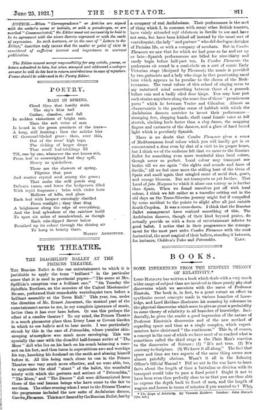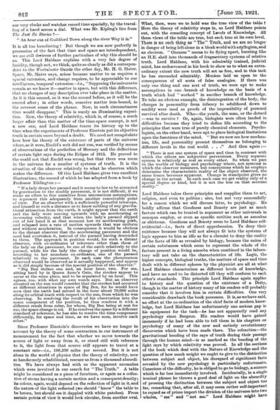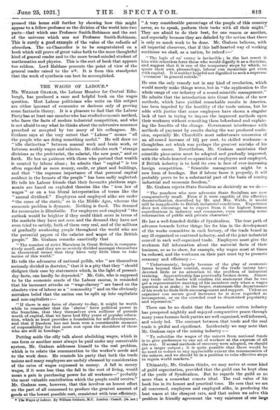BOOKS.
SOME DIFERENCES FROM THE EiNSTEM THEORY OF RELATIVITY.*
LORD HALDANE has written a book which deals with a very much wider range of subject than are involved in those purely physical discoveries •which we associate with the name of Professor Einstein. The book is, in fact, to a great extent an effort to synthesize recent concepts made in various branches of know- ledge, and. Lord Haldane-illustrates his meaning by reference to the physioaldiscoveries which seem to give so great a probability to some theory of relativity in all branches of knowledge. Inci- dentally, he gives the reader a good impression of the nature of Professor Einstein's discoveries and of the new method of regarding space and time as a single complex, which experi- menters have christened " the continuum." This is, of course, a concept in the case of which we have most of us reached what is sometimes called the third stage o the Plain Man's reaction to the discoveries of Science : (1) " It's not true. (2) It's contrary to Scripture. (3) We knew it all along." The fact that space and time are two aspects of the same thing seems now almost painfully obvious. Wasn't it all in the Infantri Officer's Official Manual ? Did we not in the war have to learn facts about the length of time a battalion or division with its transport would take to pass a fixed point ? Ought it not to have been even then perfectly clear to us that you are thus able to express the depth back to front of men, and the length of wagons and horses in terms of minutes if you wanted to ? Why, '.the Reign of Itelatioast. By Viscount lialdsca. London: John Murata I21s. net.]
our very clocks and watchas record time apacially, by the travel- ling of a hand across a dial. What was Mr. Kipling's line from The Just So Stories ?-
" An hour out of Guildford Town along the river Wey it is."
It is all too humiliating ! But though we are now perfectly in possession of the fact that time and space are interdependent, we are still desirous of further particulars of why this should be so. This Lord Haldane explains with a very fair degree of
lucidity, though not, we think, quite so clearly as did a correspon- dent to the Westminster Gazette the other day, Mr. H. G. Slater.
Space, Mr. Slater says, arises because matter to us requires a spacial extension, and change requires, to be appreciable to our intelligence, temporal extension—i.e., "Supposing the universe to remain as we know it—matter in space, but with this difference, that no changes of any description ever take place in the matter.
As it is this second, so it was the second before, so it will be the second after ; in other words, conceive matter iron-bound, in the severest sense of the phrase. Now, in such circumstances time would disappear." This is surely an illuminating exposi- tion. Now, the theory of relativity, which is, of course, a much larger affair than this matter of the time-space concept, is not a new one, and Lord Haldane traces its history up to the time when the experiments of Professor Einstein put its objective truth in certain cases beyond a doubt. We need not recapitulate here how his theory of the existence of parts of the universe where, as it were, Euclid's writ did not run, was verified by means
of observations of the perihelion of Mercury and the deflections of certain light rays during the Eclipse of 1915. He proved to the world not that Euclid was wrong, but that there was room
in the universe for a number of systems of truth. It is the situation of the observer relatively to what he observes which makes the difference. Of this Lord Haldane gives two excellent illustrations, the second of which he has adapted from a book by Professor Eddington :—
" If a lady drops her parasol and it seems to her to be attracted by gravitation to the muddy pavement, it is not difficult, if we make an effort to free ourselves from unconscious assumptions, to represent this adequately from another conceivable point of view. For an observer with a sufficiently powerful telescope, and himself at such a distance as to know nothing of any gravita- tional attraction from the earth, it might appear that the earth and the lady were moving upwards with an accelerating or increasing velocity, and that when the lady's parasol slipped out of her hand it at that moment lost its accelerating push, and relapsed into a rate of motion upwards that was uniform and without acceleration. In consequence it would be obvious to the distant observer that the accelerating pavement and the mud had overtaken it, instead of the parasol having descended to them. The approach in position would, for such a distant observer, with co-ordinates of reference other than those of the lady on the pavement, be one of the earth relatively to the parasol, while for the lady the change of position would be, according to her mundane co-ordinates, one of the parasol relatively to the pavement. In each case the phenomenon observed would be observed as it actually happened, and appear as it did simply because of the special position of the observer." " Big Ben strikes one and, an hour later, two. For me, sitting hard by in Queen Anne's Gate, the strokes appear to occur at the same place, and to be separated by an hour. This agrees, too, with what my own watch says. But an observer situated on the sun would consider that the strokes had occurred at different situations in space of Big Ben, for ho would have seen that the earth had moved in the hour about 70,000 miles along its orbital track with respect to the sun, from which he was observing. In resolving the result of his observation into the space component of the position, he thus resolves it with a different result from mine, for whom, Big Ben being at rest for me, the space change is nil. If he resolves the space by a different standard of reference, he has also to resolve the time component differently, for space and time, as we have seen, involve each other."
Since Professor Einstein's discoveries we have no longer to account by the theory of some contraction in our instrument of measurement for the fact that whether we move towards the
source of light or away from it, or stand still with reference to it, the light from that source still appears to travel at a constant rate—i.e., 186,330 miles per second. But it is not
alone in the world of physics that the theory of relativity, now so handsomely rehabilitated, rescues us from a thousand absurdi- ties. We have always had with us the apparent anomalies which were involved in our search for " The Truth." A table might be considered as a piece of furniture, or again as a collec- tion of atoms having a certain motion and a consequent density; its colour, again, would depend on the reflection of light in it, and the nature of the light reflected (we should "know" the table to be brown, but should see it dappled with white patches). From certain points of view it would look circular, from another oval. What, then, were we to hold was the true view of the table ? Here the theory of relativity steps in, as Lord Haldane points out, with the consoling concept of Levels of Knowledge. All these views of the table are true, but each true at its own level.
There is no such thing as "The" Truth, and we are no longer
in danger of being left alone in a bleak world with &syllogism, and an electron. " Oneness " seems to be flying apart, bursting like an H.E. shell into thousands of fragmentary systems of relative truth. Lord Haldane, with bis admirably trained, judicial mind, has endeavoured in his book to show us to what an extra- ordinary extent the new truth will set us free, and in this task he has succeeded admirably. Monism laid us open to the consequences of all sorts of false analogies. If there was only one thing and one sort of truth, we were apt to make assumptions in one • branch of knowledge on the basis of a truth which had " worked " in another branch of knowledge.
To take an obvious example, the disintegration of the body, the changes in personality from infancy to adulthood down to senility were used as proofs of the impossibility of personal survival after death. Who—the youth, the man, or the dotard was to survive ? Or, again, biologists were often landed in difficulties because they tried to define life according to the principles that were true of purely chemical elements. Psycho- logists, on the other hand, were apt to place biological limitations upon the functions of the mind. " But we now see how mechan- ism, life, and personality present themselves as belonging to different levels in the real world. . . ." And then again
There is not one system of space and time in contrast with which the others are subjective perversions. Every separate system is relatively as real as every other. So when we pass to the worlds of biology and psychology where, not systems in which the observer measures, but conceptions which he employs determine the characteristic reality of the object observed, the same lesson becomes apparent. Change in standpoint gives no change in the actual. In each such case we get reality only of a special degree or kind, but it is not the less on that account reality."
Lord Haldane takes these principles and reapplies them to art, religion, and even to politics ; also, but not very successfully
for a reason which we will discuss later, to psychology. He boldly affirms that Goodness and Beauty are just as much
factors which can be treated in argument as other universals in common employ, or even as specific entities such as amoebas or electrons. Goodness and Beauty seem to Lord Haldane self- evidential—i.e., facts of direct apprehension. To deny their existence because they will not always fit into the systems of logic appears to him as idle as for a chemist to deny the reality of the facts of life as revealed by biology, because the union of certain substances which seem to represent the whole of the factors present in a living amoeba when combined in the labora- tory will not take on the characteristics of life. Logic, the higher concepts, biological truths, the matters of space and time dealt with in different spheres by the physicist are all at what Lord Haldane characterizes as different levels of knowledge, and have no need to be distorted till they will conform to each other's standards. This principle Lord Haldane again applies to history and the question of the existence of a Deity, though in the matter of history many of his readers will probably
consider that it involves him in certain difficulties. One very considerable drawback the book possesses. It is, as we have said,
an effort at the co-ordination of the chief facts of modern know- ledge, but Lord Haldane has unfortunately one serious gap in his equipment for the task—he has not apparently read any psychology since Bergson. His readers would have gained immensely if he had been able to tell them in his chapters on psychology of many of the new and entirely revolutionary discoveries which have been made there. The refraction—the gravitational bending of the rays of truth during their passage through the human mind—is as marked as the bending of the light rays by which relativity was proved. In all the sections of the book which deal with the Nature of Knowledge and the question of how much weight we ought to give to the distinction between subject and object, his disregard of significant facts revealed by the new psychology is particularly unfortunate. Conscious of the difficulty, he is obliged to go to biology, a science
which is far less immediately involved. Incidentally, in a single ironical phrase he throws a good deal of light on the absurdity
of pressing the distinction between the subject and object too far, remarking that, after all, it may seem rather self-important
to regard as of prime import the division of the universe into two wholes, " me " and " not me." Lord Haldane might have pressed this home still further by showing how this might appear to a fellow-professor as the division of the world into two parts—that which was Professor Smith-Robinson and the rest of the universe which was not Professor Smith-Robinson. This is surely a good example of the value of the reductio ad absurdum. The ex-Chancellor is to be oongratulated on a book which will prove of great value both to the more thoughtful kind of general reader and to the more broad-minded student of mathematics and physics. This is the sort of book that appears too seldom. Lord Haldane presents the point of view of the general reader raised to the n'h . It is from this standpoint that the work of synthesis can best be accomplished.




































 Previous page
Previous page